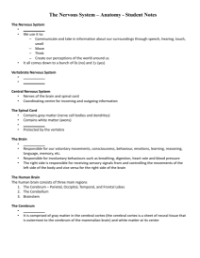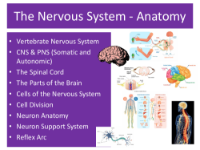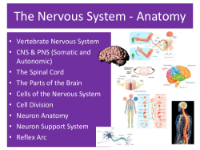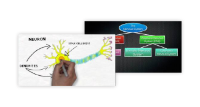2-Minute Neuroscience: The Neuron
Video
Science
+1
Science
8th Grade - 10th Grade
Premium

N
Neuroscientifically Challenged
Science Resource Description
In this video, I discuss the neuron, briefly touching on all of the parts of a neuron including the dendrites, soma, axon hillock, axon, and axon terminals or synaptic boutons. I describe how a signal travels from the dendrites of a neuron, down the axon, and to the axon terminals to communicate with another neuron through the release of neurotransmitter.
For a more in-depth 10-Minute Neuroscience video on the parts of a neuron, watch this: https://youtu.be/5p9ucgRDie8
For an article (on my website) explaining the structure and function of neurons, click this link: https://neuroscientificallychallenged.com/posts/know-your-brain-neurons
The image of a brain used in this video is a CC image courtesy of _DJ_ on Flickr. The work can be seen here: https://flic.kr/p/dLbzPm and the CC license can be seen here: https://creativecommons.org/licenses/by/2.0/
TRANSCRIPT:
Welcome to 2 minute neuroscience, where I simplistically explain neuroscience topics in 2 minutes or less. In this installment I will discuss the neuron.
This is a brain. Estimates vary but right now the best guess seems to be that our brains contain around 85 billion neurons. The neuron is a nerve cell and is the primary functional unit of the nervous system.
This is a generic image of a neuron. Neurons actually come in all shapes and sizes but is the prototypical version of a neuron that you’ll often see in a textbook. These structures extending from the left side of a neuron that look a little bit like tree branches are called dendrites.
Dendrites are the area where neurons receive most of their information. There are receptors on dendrites that are designed to pick up signals from other neurons that come in the form of chemicals called neurotransmitters. Those signals picked up by dendrites cause electrical changes in a neuron that are interpreted in an area called the soma or the cell body. The soma contains the nucleus. The nucleus contains the DNA or genetic material of the cell. The soma takes all the information from the dendrites and puts it together in an area called the axon hillock. If the signal coming from the dendrites is strong enough then a signal is sent to the next part of the neuron called the axon. At this point the signal is called an action potential.
The action potential travels down the axon which is covered with myelin, an insulatory material that helps to prevent the signal from degrading. The last step for the action potential is the axon terminals, also known as synaptic boutons. When the signal reaches the axon terminals it can cause the release of neurotransmitter. These purple structures represent the dendrites of another neuron. When a neurotransmitter is released from axon terminals, it interacts with receptors on the dendrites of the next neuron, and then the process repeats with the next neuron.
REFERENCE:
Purves D, Augustine GJ, Fitzpatrick D, Hall WC, Lamantia AS, McNamara JO, White LE. Neuroscience. 4th ed. Sunderland, MA. Sinauer Associates; 2008.
Explore other content in this scheme
Part of a lesson by Teach with Fergy
Other resources in this lesson

Nervous System - Get to know our nervous system a bit closer, how does it works? | Neurology
Resource
Science
+1
11th Grade - 12th Grade

063 The Divisions of the Nervous System
Resource
Science
+1
11th Grade - 12th Grade

What is a Reflex Arc | Physiology | Biology | FuseSchool
Resource
Science
+1
11th Grade - 12th Grade

The Nervous System - Anatomy - Exit Ticket
Resource
Science
+1
11th Grade - 12th Grade

The Nervous System - Anatomy - Student Lesson Outline
Resource
Science
+1
11th Grade - 12th Grade

The Nervous System - Anatomy - Student Presentation
Resource
Science
+1
11th Grade - 12th Grade

The Nervous System - Anatomy - Teaching Presentation
Resource
Science
+1
11th Grade - 12th Grade
